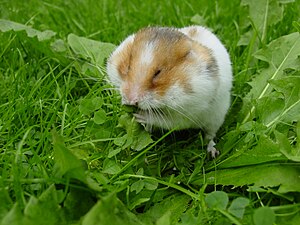AY Honors/Small Mammal Pets/Answer Key
The Syrian Hamster or Golden Hamster, Mesocricetus auratus, is the best known member of the rodent subfamily Cricetinae, the hamsters. In the wild they are now considered endangered &, but are popular as housepets and scientific research animals. Adults grow from 5 to 7 inches (12.5 to 17.5 cm ) in length, and will usually have a lifespan of 2 to 3 years.
Biology
Like most members of the subfamily, the Syrian Hamster has expandable cheek pouches, which extend from its cheeks to its shoulders. In the wild, hamsters are larder hoarders; they use their cheek pouches to transport food to their burrows. Their name in the local Arabic dialect where they were found translates to "father of saddlebags" due to the remarkable amount of storage space in their cheek pouches. If food is plentiful, they will store it in large amounts--it has been reported that 25 kg of grain was found in the burrow of a single hamster.
Sexually mature female hamsters come into season (oestrus) every four days. Putting a male and female hamster together when the female is not in heat may result in the female attacking the male. Syrian Hamsters have the shortest gestation period in any known mammal at only 16 to 18 days. They can produce large litters of 20 or more young, although the average litter size is 8. If a mother hamster is inexperienced or feels threatened, she may abandon or even cannibalise her pups. It is inadvisable for inexperienced owners to breed them.
Most hamsters in American and British pet stores are Syrian Hamsters. Originally, Syrian Hamsters came in just one colour — the mixture of brown, black, and gold which gave them their "Golden" name — but they have since developed a myriad of colour mutations such as cream, white, blonde, banded, tortoiseshell, calico, and sable. Therefore in pet stores today, Golden Hamster is only used to label the original coloration (also known as agouti). Other-coloured short-hairs are banded under the label Fancy Hamster. Teddy Bear is a term used to describe the long-haired variety of the Syrian Hamster, named so for their remarkable resemblance to toy teddy bears. They are also sometimes known as "angora hamsters". Male teddy bear hamsters usually have much longer fur than the female variety, culminating in a "skirt" of longer fur around their backsides. Black Bears are a recent off-shoot of teddy bear hamsters (mutation discovered in 1985), with their major difference being their black-coloured fur. It can be argued that black bears are just black teddy bears rather than their own breed; on the other hand, black bears were originally selectively bred for their larger size and more docile nature as well as their colour. However, in current stock, this may or may not still be the case.
Syrian Hamsters are wildly popular as housepets due to their docile, inquisitive natures and small size. They are popular as "first pets" for young children, as well as being classroom animals, because of their hardiness and relative ease of care. Some pet owners find them more attractive in relation to rats and other rodents due to their lack of visible tails. Syrian Hamsters are notoriously territorial, however. Even tame Syrian Hamsters will frequently attack and, indeed, kill, other adult hamsters. When kept as pets, Syrians must be housed in single sex groups after the age of six weeks, and housed individually by the time they are ten weeks old.
Syrian Hamsters have also been used in scientific research — in the study of many diseases, as well as in the study of behaviour. They have a number of fixed action patterns that are readily observed, including scent-marking. They are particularly used in airway and respiratory physiology research.
Discovery
In 1839 British zoologist George Robert Waterhouse reportedly found an elderly female hamster in Syria, naming it Cricetus auratus, the Golden Hamster. The hamster's fur was on display at the British Museum (Natural History). The Syrian Hamster was then ignored by European science for the next century.
In 1930, Israel Aharoni, a zoologist and professor at the Hebrew University of Jerusalem, captured a mother hamster and her litter of babies in the Syrian desert. By the time he got back to his lab, most had died or escaped. The remaining three hamsters were given to his university, where they were successfully bred. Because they were a bit bigger than the ones Waterhouse found, they were named Mesocricetus auratus. Mesocricetus auratus is the currently accepted scientific name of the Syrian Hamster.
Descendants of these hamsters were shipped to scientific labs around the world for use as research animals. They arrived in the United Kingdom in 1931, and reached the United States in 1938. Soon after their initial discovery, they were found to make great pets. Just about all captive Syrian Hamsters today are descended from the original litter found in Syria, except for a few that were brought into the United States by travellers who found them in the desert. A separate stock of hamsters was imported into the US in 1971, but it is not known if any of today's North American pets are descended from them.
j
Gallery
- 100 983.jpg
A Golden Hamster
- Jan2306 122.jpg
male teddy bear hamster
See also
References
- ↑ Template:IUCN2006 Listed as Endangered (EN B1+2c v2.3)
External links
- Genome information
- Petwebsite Entry on Syrians
- The River Road Hamstery- Very good information on hamster breeding, especially for coat types
- The Hamster Society
- Rabbits N' Rodents
- RaztheHamster - Syrian Hamster Gallery
bg:Златист хамстер da:Guldhamstere de:Goldhamster fr:Hamster doré it:Mesocricetus auratus he:אוגר זהוב nl:Goudhamster ja:ゴールデンハムスター nn:Syrisk hamster pl:Chomik syryjski fi:Kultahamsteri sv:Guldhamster zh:敘利亞倉鼠



